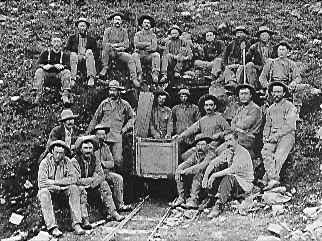Panning
Techniques
GOLD panning is
a great pastime. With some practice you can develop technique and pan cleanly
and quickly.
Panning often takes you to beautiful country
and, if you wish, into remote country. And you find GOLD.
It's great to see a trail of colors in the bottom of the pan!
Panning is most rapidly learned by watching
and panning beside an experienced panner, but following these suggestions
you can teach yourself and soon begin to pan like an old time Colorado
Gold Prospector.

Prospecting Terms:
Placer
– A deposit or accumulation of rock waste formed by process of sedimentation,
mass wasting or weathering in which natural processes have mechanically
brought about a relative concentration of GOLD
or other heavy minerals.
Classifier or Grizzly –
A screen or strainer to get rid of larger material.
Material – “Dirt”
Sniffer Bottle
– A suction device “vacuum bottle” used to suck the desired material out
of your pan.
Dredging
- Dredging is the mining of placer gravel's to beneath local water levels
employing mechanical excavation and a floating plant. The material is sucked
from the riverbed with a gas vacuum and circulated through a floating seclude
box. Very efficient.
Hand Sluce
- A portable box with built in riffles that obstruct the flow of gravel's
being moved by the water.
Black
Sand---“Magnetite“
FLOUR----
Fine Fine powder GOLD
SPECK-----bigger
than FLOUR GOLD,
but still too small to pick out of the pan.
FLECK-----This
is like a SPECK, but flatter in shape.
FLAKE-----A
FLAKE is larger in size. A FLAKE is too small to pick up with your fingers,
but can be removed with a pair of tweezers.
PICKER----This
is a piece of GOLD
big enough to pick out of your pan with your fingers.
Nugget
--- Come on now!
Heavy Minerals Found in Colorado:
Quartz and feldspar, then greenish epidote,
then garnet (usually reddish) and black tourmaline, then brassy yellow
pyrite and black magnetite and finally, with luck - GOLD...
Let's start Panning Prospector:
If panning in a stream or lake, pan where
the water is shallow but the pan can be held and shaken under water. If
in a stream, the water must be only gently moving, so that the contents
of the pan will not wash out. Ideally the water should be four to seven
inches deep, so the pan can be rested on the bottom.
If panning away from a lake or stream, work
over a tub or other container large enough that the loaded pan can be submerged
and ideally, manipulated in it. This not only facilitates the panning but
prevents having to pour water into the pan, permits filling the pan higher
and provides a trap for the tailings or run away nuggets.
Submerge the pan in water and vigorously shuffle
it from side to side to shake the GOLD
down through the material and into the pan. Repeat this process as
often as necessary until all material, which is 1/4 inch and smaller has
gone through the screen. Remove the screen.
Submerge the pan gently, using a side to side
motion and keeping the pan slightly submerged and angled in the water.
Repeat the vigorous shuffle to get the heavier
material back down to the bottom of the pan. Repeat until only the fine
material remains in the pan. Remove any larger materials or items such
as lead, nails, bullets, etc.
“Most panners make the mistake of panning
all the material without allowing the heavy deposits to be shuffled to
the bottom”.
After panning the remaining material down to
just the black sand “Magnetite“ take the pan out of the water leaving
just enough to move the material by swirling. With a swirling motion the
water will start to move the black sand to the side from which you are
swirling from. Watch closely as you should see GOLD
flour, flakes or even pickers submerge from the edge of the black sand.
Some prospectors do not like touching the pan
as this leaves oil from your fingertips in the pan which might make the
GOLD
float.
Instead use your sniffer bottle “a suction device” or tweezers to remove
the GOLD.
There are many methods used today to remove
the flour GOLD
and small flakes. I have found that the GOLD
separator
"fine sluice box" works the best. To see a plan on how to make one
click the GOLD
pan at the bottom of this page.
Now all you have left is to Go cash in you
big find and make a claim!!!!

Back to Colorado Gold
Prospecting

